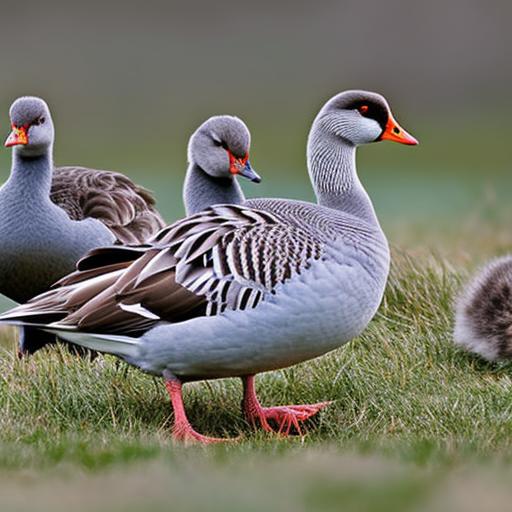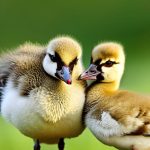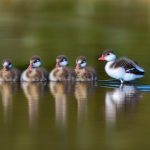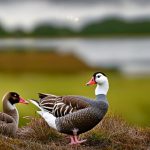Gray geese breeds have a long and rich history, dating back thousands of years. These birds have played a significant role in agriculture and conservation efforts, making them an important species to study and understand. Gray geese breeds are known for their distinctive gray plumage and their ability to adapt to various environments. In this article, we will explore the different types of gray geese breeds, their physical characteristics, habitat and range, diet and feeding habits, reproduction and breeding patterns, behavioral patterns, domestication pros and cons, conservation efforts, and their significance in popular culture and folklore.
Key Takeaways
- Gray geese breeds are a diverse group of waterfowl that are found all over the world.
- There are several different types of gray geese breeds, including the Canada goose, the greylag goose, and the snow goose.
- Physical characteristics of gray geese breeds include a long neck, webbed feet, and a distinctive honking call.
- Gray geese breeds can be found in a variety of habitats, from wetlands to grasslands to urban areas.
- Gray geese breeds are herbivores that feed on a variety of plants, including grasses, sedges, and aquatic vegetation.
The Different Types of Gray Geese Breeds
There are several different types of gray geese breeds, each with its own unique characteristics. The most common types include the Canada goose, the greylag goose, the barnacle goose, and the snow goose.
The Canada goose is one of the most recognizable gray geese breeds. It has a black head and neck with a white chinstrap, a brownish-gray body, and a long black neck. The greylag goose is another well-known breed with a grayish-brown body and a distinctive orange beak. The barnacle goose has a black head and neck with white cheeks and a grayish-brown body. Finally, the snow goose is known for its white plumage with black wingtips.
In terms of behavior, gray geese breeds are known for their strong social bonds and their ability to migrate long distances. They often form large flocks during migration and breeding seasons. They are also highly territorial and will defend their nesting sites aggressively.
Physical Characteristics of Gray Geese Breeds
Gray geese breeds have several physical characteristics that help them survive in the wild. Their plumage provides excellent camouflage in their natural habitats, allowing them to blend in with their surroundings and avoid predators. Their long necks and strong wings enable them to fly long distances during migration. They also have webbed feet, which are adapted for swimming and foraging in water.
In addition to their physical adaptations, gray geese breeds have a unique vocalization system. They use a variety of honks, hisses, and grunts to communicate with each other and establish their territory. These vocalizations are an important part of their social behavior and breeding rituals.
Habitat and Range of Gray Geese Breeds
Gray geese breeds are found in a wide range of habitats, including wetlands, grasslands, and coastal areas. They are highly adaptable and can thrive in both urban and rural environments. However, human activities have had a significant impact on their natural habitat and range.
The destruction of wetlands for agriculture and urban development has led to a decline in suitable nesting sites for gray geese breeds. Pollution from industrial activities and the use of pesticides have also affected their food sources and water quality. Climate change is another major threat, as it alters the timing of migration and breeding patterns.
Diet and Feeding Habits of Gray Geese Breeds
Gray geese breeds have a varied diet that consists mainly of plant matter such as grasses, sedges, and aquatic vegetation. They also eat insects, mollusks, and small fish when available. During migration, they rely on agricultural fields for food, feeding on crops such as corn and wheat.
Their feeding habits have adapted to their environment. For example, they have long necks that allow them to reach vegetation underwater while swimming. They also have serrated bills that help them tear through tough plant material.
Reproduction and Breeding of Gray Geese Breeds
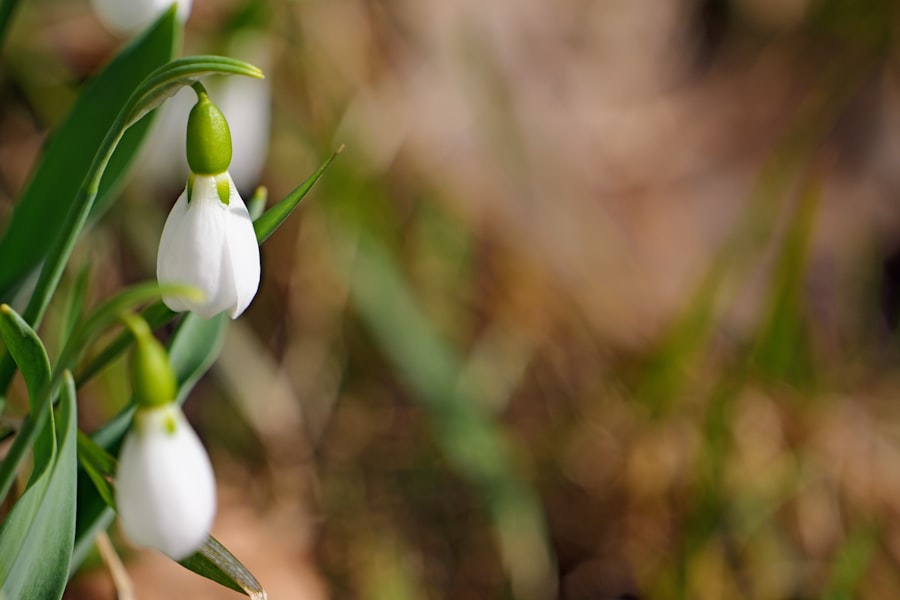
Gray geese breeds typically mate for life and form strong pair bonds. The breeding season varies depending on the species and the location, but it generally occurs in the spring or summer. During this time, the male and female engage in courtship displays, which involve head bobbing, wing flapping, and honking.
The female gray goose builds a nest on the ground using grasses and other plant materials. She lays a clutch of eggs and incubates them for about a month. Both parents take turns incubating the eggs and caring for the young. The goslings are precocial, meaning they are able to walk and swim shortly after hatching.
Behavioral Patterns of Gray Geese Breeds
Gray geese breeds exhibit a variety of behavioral patterns throughout the year. During the breeding season, they become highly territorial and will aggressively defend their nesting sites from intruders. They also engage in courtship displays to attract a mate.
During migration, gray geese breeds form large flocks and fly in a V-formation. This formation helps them conserve energy by taking advantage of the updraft created by the bird in front of them. It also allows them to communicate and stay together as a group.
In the winter months, gray geese breeds gather in large numbers in areas with abundant food sources. They form tight-knit flocks for protection and warmth. They are highly social birds and will often communicate with each other through vocalizations.
Domestication of Gray Geese Breeds: Pros and Cons
The domestication of gray geese breeds has both advantages and disadvantages. On one hand, domesticated geese can provide a sustainable source of meat, eggs, and feathers. They are also used for weed control in agricultural fields and as guard animals to deter predators.
However, domestication can also have negative effects on gray geese breeds. It can lead to genetic changes that make them less adapted to survive in the wild. Domesticated geese may also lose their migratory instincts and become dependent on humans for food and shelter.
Conservation Efforts for Gray Geese Breeds
Conservation efforts for gray geese breeds focus on protecting their natural habitats, restoring wetlands, and reducing human disturbances. Organizations and individuals can contribute to their conservation by supporting habitat restoration projects, advocating for the protection of wetlands, and promoting responsible bird-watching practices.
Gray Geese Breeds in Popular Culture and Folklore
Gray geese breeds have been portrayed in popular culture and folklore in various ways. In some cultures, they are seen as symbols of loyalty, fidelity, and family values. They are often associated with migration, freedom, and the changing seasons.
In popular culture, gray geese breeds have been featured in literature, art, and music. They are often depicted as majestic birds with a strong sense of community and family. Their distinctive honking calls are also used to create atmospheric sound effects in movies and television shows.
Gray geese breeds are fascinating creatures that play a vital role in the ecosystem and human society. Their physical characteristics, behavior, and adaptability make them a species worth studying and conserving. By understanding their needs and protecting their habitats, we can ensure the survival of these remarkable birds for future generations to enjoy.
If you’re interested in learning more about gray geese breeds, you might also find this article on poultrywizard.com fascinating. It discusses the number of eggs geese lay and provides valuable insights into the breeding process. Understanding the egg-laying habits of geese is crucial for successful breeding and raising of these beautiful birds. To read more about it, click here: https://poultrywizard.com/breeding-geese/how-many-eggs-do-geese-lay/.
FAQs
What are gray geese breeds?
Gray geese breeds are a group of domesticated geese that have gray feathers. They are commonly raised for their meat, eggs, and feathers.
What are some examples of gray geese breeds?
Some examples of gray geese breeds include the Toulouse, Embden, and Pilgrim geese.
What is the size of gray geese breeds?
Gray geese breeds can vary in size, but they are generally larger than other domesticated geese breeds. They can weigh anywhere from 10 to 20 pounds.
What is the lifespan of gray geese breeds?
The lifespan of gray geese breeds can vary depending on their living conditions and care. On average, they can live up to 10-15 years.
What is the temperament of gray geese breeds?
Gray geese breeds are generally calm and docile, making them easy to handle and raise. However, like any animal, they can become aggressive if they feel threatened or if they are protecting their young.
What is the diet of gray geese breeds?
Gray geese breeds are herbivores and primarily feed on grass, grains, and other vegetation. They also require access to clean water for drinking and bathing.
What is the breeding season for gray geese breeds?
The breeding season for gray geese breeds typically occurs in the spring and summer months. During this time, they will lay eggs and care for their young.
Meet Walter, the feathered-friend fanatic of Florida! Nestled in the sunshine state, Walter struts through life with his feathered companions, clucking his way to happiness. With a coop that’s fancier than a five-star hotel, he’s the Don Juan of the chicken world. When he’s not teaching his hens to do the cha-cha, you’ll find him in a heated debate with his prized rooster, Sir Clucks-a-Lot. Walter’s poultry passion is no yolk; he’s the sunny-side-up guy you never knew you needed in your flock of friends!

